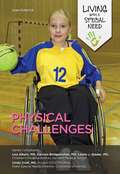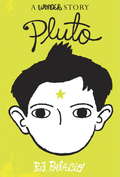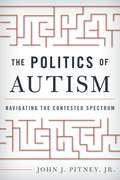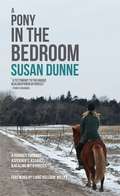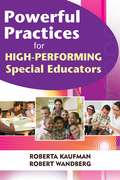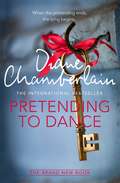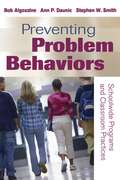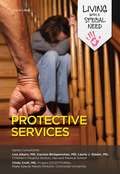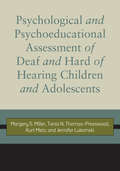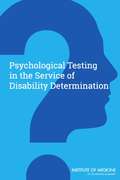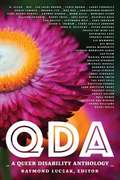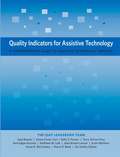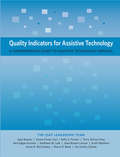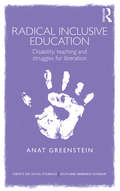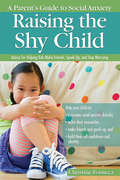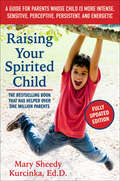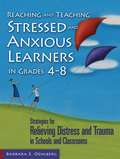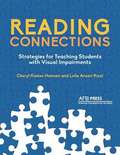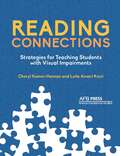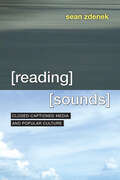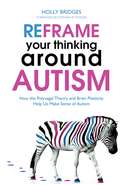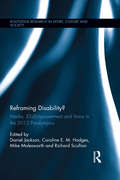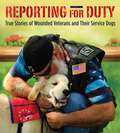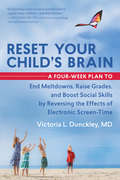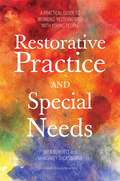- Table View
- List View
Physical Challenges
by Joan EsherickThere are many kinds of physical challenges. Some of these are the result of an injury, while other challenges are caused by a condition with which the person was born. Many of these conditions will last forever, and some will get worse as the individual gets older. When fourteen-year-old Samantha discovers that her new neighbor, Jenny, has cerebral palsy and uses a wheelchair, Samantha's not sure what to expect. Through her growing friendship with Jenny, though, Samantha meets other kids with physical challenges. Each of these new friends has a different physical condition and faces different difficulties--and each one teaches Samantha a new lesson about how to look at others.
Pluto: A Wonder Story
by R. J. PalacioAlmost 2 million people have read the New York Times bestseller Wonder and fallen in love with Auggie Pullman. Last year readers were given a special look at another side of his story with The Julian Chapter, and now they'll get a peek at Auggie's life before Beecher Prep, with an exclusive new short story told entirely from the point of view of Christopher, Auggie's oldest friend. Christopher was Auggie's best friend from the time they were babies until his family moved away; he was there through all of Auggie's surgeries and heartbreaks, through bad times and good--like Star Wars marathons and dreams of traveling to Pluto together. Alternating between childhood flashbacks and the present day, an especially bad day for Christopher, Pluto is the story of two boys grown apart learning that good friendships are worth a little extra effort.
The Politics of Autism: Navigating the Contested Spectrum
by John J. PitneyIn the first book devoted exclusively to the contentious politics of autism, noted political scientist and public policy expert John J. Pitney, Jr. , explains how autism has evolved into a heated political issue disputed by scientists, educators, social workers, and families. Nearly everything about autism is subject to debate and struggle, including its measurement and definition. Organizational attempts to deal with autism have resulted in not a single autism policy, but a vast array of policies at the federal, state, and local levels, which often leave people with autism and their families frustrated and confused. Americans with autism are citizens, friends, coworkers, sons, daughters, fathers, and mothers. No longer simply the objects of public policy, they are active participants in current policy debates. Pitney s fascinating look at how public policy is made and implemented offers networks of concerned parents, educators, and researchers a compass to navigate the current systems and hope for a path towards more regularized and effective policies for America s autism community. "
A Pony in the Bedroom: A Journey through Asperger's, Assault, and Healing with Horses
by Susan Dunne Liane Holliday WilleySusan Dunne's life changed forever when a chance question from a doctor led her back to horses, an unfulfilled childhood passion. Detached and isolated due to undiagnosed autism, Susan had already survived rape, battled eating disorders and self-harm, and spent time homeless, when her world was turned upside again by a vicious, life-threatening assault. Severe post-traumatic stress disorder left her feeling distrustful and more cut off than ever before from a world she saw as confusing and dangerous. But as Susan's connection with horses grew stronger, her world started to open up. Poignant and witty by turns, Susan shares her story of survival and transformation, offering a rare insight into her relationship with horses, and how they helped her to find a safe place in the world.
Powerful Practices for High-Performing Special Educators
by Robert Kaufman Robert WandbergSpecial education teachers face unique challenges, especially when they are just beginning. This essential resource offers special educators a blueprint for dealing with the most common challenges they face both in the classroom and in the larger school environment. These research-based strategies help teachers meet the academic needs of diverse students with disabilities (including those who are also English language learners) in areas such as setting up a classroom, managing student behavior, designing effective instruction, incorporating technology, embracing diversity, and more. Each chapter features: -An overview and objectives -A brief research review -Step-by-step strategies that can be used immediately -Examples and scenarios from real teaching experiences -Self-assessments and reflections This all-in-one reference book offers the tools, strategies, and support special educators need for success in their first year and every year thereafter!
Pretending to Dance
by Diane ChamberlainBack Cover: "Molly Arnette and her husband live in San Diego, where they hope to adopt a baby. But the process terrifies her. As the background checks begin, Molly worries that secrets from her North Carolina childhood will resurface and destroy not only her chance at adoption but her marriage as well. She ran away from her family twenty years ago after a devastating event left her distrustful of those she loved: her mother, the woman who raised her and who--despite Molly claiming otherwise--is very much alive; her birth mother, whose mysterious presence raised so many issues, and the father she adored, whose death sent her running from the small community of Morrison Ridge. Now, as she tries to find a way to make peace with her past and embrace a future filled with promise, she discovers that even she doesn't know the truth of what happened in her family of pretenders."
Preventing Problem Behaviors: Schoolwide Programs and Classroom Practices
by Bob Algozzine Stephen W. Smith Ann P. DaunicIn today's increasingly diverse PreK-12 classrooms, problem behaviors can often interrupt instructional time and disrupt learning. Designed for 21st-century school leaders, administrators, behavior specialists, and classroom teachers, this research-based guide offers specific strategies and plans for preventing problem behavior at both the classroom and school level. Based on the premise that early response to problems can lead to better outcomes for students, the book's content is framed around four essential areas: foundations, intervention, collaboration, and evaluation. Within these areas, this accessible guide features: -The latest information on the science and practice of prevention -Reasons why conflict resolution, peer mediation, and bully-proofing are essential to prevention -Effective practices for teaching social skills to young children -Proven techniques for implementing schoolwide positive behavior support -Tools for using individual behavior plans to prevent problems -Ideas for home-school and community partnerships and culturally responsible teaching -Critical strategies for monitoring student progress and evaluating prevention practices -New, updated chapters, including information on preschool behavior support and RTI This valuable resource provides all the tools and strategies school leaders and teachers need to keep children focused on learning.
Protective Services
by Joyce LibalNot every child is lucky enough to live in a safe, loving home. Many young people live in difficult, unhealthy, or even dangerous conditions. Luckily, there are systems in place to help kids caught in theses situations. Child protective services are working hard to help children in need. Ryan Delaney is one of these kids. He spends most of his time living in a fantasy world, because that's easier than facing his real life. He lies to his friends about his parents and his home--but eventually, the truth catches up with him, forcing him to get the help he needs. As you read Ryan's story, you will learn about the history of the child protective services and find out about the programs and services offered today.
Psychological and Psychoeducational Assessment of Deaf and Hard of Hearing Children and Adolescents
by Margery S. Miller Jennifer Lukomski Tania N. Thomas-Presswood Kurt MetzThe obstacles to valid and meaningful assessment of deaf and hard of hearing children and adolescents are great, yet professionals are regularly asked to conduct comprehensive evaluations to determine resource and program eligibility, test modifications in school, classroom and home recommendations, and referrals. In this important new text, the authors define the skills required of the examiners, explain the complex nature of these assessments, and describe ways to intelligently use existing tests. Authors Margery S. Miller, Tania Thomas-Presswood, Kurt Metz, and Jennifer Lukomski bring a wealth of knowledge and experience to this in-depth treatment of topics essential to educators and school psychologists. They cover such critical areas as test construction and measurement; the diversity in American Deaf culture; the role of parents in the assessment process; neuropsychological assessments; nonverbal methods for assessing intelligence; and the need for sign language competency when testing cognitive and language skills. The text concludes with recommendations for the development of valid and reliable tests for all students who are deaf and hard of hearing.
Psychological Testing in the Service of Disability Determination
by Committee on Psychological Testing Including Validity Testing for Social Security Administration Disability DeterminationsThe United States Social Security Administration (SSA) administers two disability programs: Social Security Disability Insurance (SSDI), for disabled individuals, and their dependent family members, who have worked and contributed to the Social Security trust funds, and Supplemental Security Income (SSSI), which is a means-tested program based on income and financial assets for adults aged 65 years or older and disabled adults and children. Both programs require that claimants have a disability and meet specific medical criteria in order to qualify for benefits. SSA establishes the presence of a medically-determined impairment in individuals with mental disorders other than intellectual disability through the use of standard diagnostic criteria, which include symptoms and signs. These impairments are established largely on reports of signs and symptoms of impairment and functional limitation. "Psychological Testing in the Service of Disability Determination" considers the use of psychological tests in evaluating disability claims submitted to the SSA. This report critically reviews selected psychological tests, including symptom validity tests, that could contribute to SSA disability determinations. The report discusses the possible uses of such tests and their contribution to disability determinations. "Psychological Testing in the Service of Disability Determination" discusses testing norms, qualifications for administration of tests, administration of tests, and reporting results. The recommendations of this report will help SSA improve the consistency and accuracy of disability determination in certain cases.
QDA: A Queer Disability Anthology
by Raymond LuczakQDA: A Queer Disability Anthology features fiction, poetry, nonfiction, and comics by 48 writers from around the world.
Quality Indicators For Assistive Technology: A Comprehensive Guide To Assistive Technology Services
by The QIAT Leadership TeamMore than 6 million children with disabilities in North America require assistive technology and related services each year in order to participate and succeed in school. This book, Quality Indicators for Assistive Technology, provides an essential guide for assessing a child's needs, choosing and implementing the right technologies and services, and training education professionals in how to optimize learning with these critical tools.
Quality Indicators for Assistive Technology: A Comprehensive Guide to Assistive Technology Services
by Susan Mccloskey Diana Foster Carl Gayl Bowser Jane Edgar Korsten Joan Breslin Larson Joy Smiley Zabala Kathleen Lalk Kelly Fonner Penny Reed Scott Marfilius Terry Vernon FossMore than 6 million children with disabilities in North America require assistive technology and related services each year in order to participate and succeed in school. This book, Quality Indicators for Assistive Technology, provides an essential guide for assessing a child's needs, choosing and implementing the right technologies and services, and training education professionals in how to optimize learning with these critical tools.
Radical Inclusive Education: Disability, teaching and struggles for liberation (Concepts for Critical Psychology)
by Anat GreensteinMany people who work in education start out with enthusiastic ideals about education as a positive force that can spur change in the life of the learner and in society at large, yet find themselves frustrated with a bureaucratic system that often alienates and excludes many of its students. This is particularly true for students identified as having "special educational needs" (SEN) or disability, a label often used to justify the ways in which students are failed by a system that focuses on narrow definitions of knowledge, seeks to normalise and control behaviour, and values economic productivity over other forms of human activity. Radical Inclusive Education explores how current educational practices, such as standardised tests and league tables, exclude and fail many disabled students, and naturalise educational inequalities around gender, class, ethnicity and ability. Informed by the social model of disability, the book argues that educational theories and practices that are geared towards social justice and inclusion need to recognise and value the diversity of human embodiments, needs and capacities, and foster pedagogical practices that support relations of interdependency. The book draws on work in disability studies, critical psychology and critical pedagogy, and also real life examples from interviews with activists in the disabled people’s movement, and from research in a school, to offer examples of what radical inclusive education – that is sensitive to the needs of all students – might look like in practice. As such, it will be of great interest to practitioners and students in the field of education, particularly for those interested in SEN and disability, sociology of education, critical pedagogy, informal education and social movement learning.
Raising the Shy Child
by Christine FonsecaThe fear of being judged by others in social activities is a common human experience, especially during childhood. But when the fear becomes all-consuming, it can disrupt daily functioning and the development of social competency. Raising the Shy Child: A Parent's Guide to Social Anxiety takes a fresh look at social anxiety disorder, coupling the latest in research trends with evidence-based strategies and real-world stories to untangle the complexities of this disorder. Presented in an easy-to-read, conversational style, the book uses a combination of real-world examples and stories from adults and children with social anxiety disorder to show parents and educators how to help children find a path through their fear and into social competence. With specific strategies to address school refusal, bullying, and identity issues, Raising the Shy Child is a must-read resource for anyone dedicated to enhancing the lives of children.
Raising Your Spirited Child, Third Edition: A Guide for Parents Whose Child Is More Intense, Sensitive, Perceptive, Persistent, and Energetic (Spirited Series)
by Mary Sheedy KurcinkaThe spirited child--often called "difficult" or "strong willed"--possesses traits we value in adults yet find challenging in children. Research shows that spirited children are wired to be "more"; by temperament, they are more intense, sensitive, perceptive, persistent, and more uncomfortable with change than the average child. In this newly revised third edition of the award-winning classic, Dr. Mary Sheedy Kurcinka provides vivid examples of real-life challenges and a refreshingly positive viewpoint. Within these pages you will find: New strategies for managing intensity levels--not just the spirited child's, but yours too A simple, four-step program for peaceful bedtimes, mealtimes, holidays, and many other commonly challenging situations A focus on your child's strengths Steps for teaching your child how to be a problem solver and how to work with others Updated guidance on establishing clear limits And more!Charts and quick tips make this newly updated edition an indispensable guide for fostering a supportive, encouraging, and loving environment for children. updated edition of Raising Your Spirited Child will help you foster a supportive, encouraging, and loving environment for your children.
Reaching and Teaching Stressed and Anxious Learner: Strategies for Relieving Distress and Trauma in Schools and Classrooms
by Barbara OehlbergThis important new resource helps educators understand how trauma and stress interfere with cognitive skills, and how classroom and school activities can be used to restore feelings of safety, empowerment, and well-being.
Reading Connections: Strategies For Teaching Students With Visual Impairments
by Cheryl Kamei-HannanReading Connections: Strategies for Teaching Students with Visual Impairments offers an in-depth and user-friendly guide for understanding reading instruction for teachers and professionals seeking to improve the reading skills of their students who are visually impaired. The book addresses in detail the essential components of reading--phonemic awareness, phonics, reading fluency, vocabulary, and reading comprehension--as well as other key reading components and subskills. While this book addresses the needs of students who read print, braille, or both, much of the book is also consistent with strategies for teaching reading to students who have, or are at risk for, developing reading disabilities. Teachers of students with visual impairments, as well as family members and other professionals who work with children who are blind or visually impaired, will find within this book a repertoire of strategies and activities for creating a balanced, comprehensive plan of reading instruction for each student and for teaching the essential reading skills necessary for students' success.
Reading Connections
by Cheryl Kamei-Hannan Leila Ansari RicciReading Connections: Strategies for Teaching Students with Visual Impairments offers an in-depth and user-friendly guide for understanding reading instruction for teachers and professionals seeking to improve the reading skills of their students who are visually impaired. The book addresses in detail the essential components of reading--phonemic awareness, phonics, reading fluency, vocabulary, and reading comprehension--as well as other key reading components and subskills. While this book addresses the needs of students who read print, braille, or both, much of the book is also consistent with strategies for teaching reading to students who have, or are at risk for, developing reading disabilities. Teachers of students with visual impairments, as well as family members and other professionals who work with children who are blind or visually impaired, will find within this book a repertoire of strategies and activities for creating a balanced, comprehensive plan of reading instruction for each student and for teaching the essential reading skills necessary for students' success.
Reading Sounds: Closed-Captioned Media and Popular Culture
by Sean ZdenekImagine a common movie scene: a hero confronts a villain. Captioning such a moment would at first glance seem as basic as transcribing the dialogue. But consider the choices involved: How do you convey the sarcasm in a comeback? Do you include a henchman's muttering in the background? Does the villain emit a scream, a grunt, or a howl as he goes down? And how do you note a gunshot without spoiling the scene? These are the choices closed captioners face every day. Captioners must decide whether and how to describe background noises, accents, laughter, musical cues, and even silences. When captioners describe a sound--or choose to ignore it--they are applying their own subjective interpretations to otherwise objective noises, creating meaning that does not necessarily exist in the soundtrack or the script. Reading Sounds looks at closed-captioning as a potent source of meaning in rhetorical analysis. Through nine engrossing chapters, Sean Zdenek demonstrates how the choices captioners make affect the way deaf and hard of hearing viewers experience media. He draws on hundreds of real-life examples, as well as interviews with both professional captioners and regular viewers of closed captioning. Zdenek's analysis is an engrossing look at how we make the audible visible, one that proves that better standards for closed captioning create a better entertainment experience for all viewers.
Reframe Your Thinking Around Autism: How the Polyvagal Theory and Brain Plasticity Help Us Make Sense of Autism
by Holly BridgesOutlining a new, optimistic way to understand autism, this concise and accessible book offers practical ideas to help children on the spectrum grow. The Polyvagal Theory suggests autism is a learnt response by the body - a result of the child being in a prolonged state of 'fight or flight' while their nervous system is still developing. This book explains the theory in simple terms and incorporates recent developments in brain plasticity research (the capacity of the brain to change throughout life) to give parents and professionals the tools to strengthen the child's brain-body connection and lessen the social and emotional impact of autism.
Reframing Disability?: Media, (Dis)Empowerment, and Voice in the 2012 Paralympics (Routledge Research in Sport, Culture and Society #41)
by Daniel Jackson Caroline E.M. Hodges Mike Molesworth Richard ScullionThe London 2012 Paralympic Games - the biggest, most accessible and best-attended games in the Paralympics' 64-year history - came with an explicit aim to "transform the perception of disabled people in society," and use sport to contribute to "a better world for all people with a disability." This social agenda offered the potential to re-frame disability; to symbolically challenge "ableist" ideology and to offer a reinvention of the (dis)abled body and a redefinition of the possible. This edited collection investigates what has and is happening in relation to these ambitions. The book is structured around three key questions: 1. What were the predominant mediated narratives surrounding the Paralympics, and what are the associated meanings attached to them? 2. How were the Paralympics experienced by media audiences (both disabled and non-disabled)? 3. To what extent did the 2012 Paralympics inspire social change? Each section of this book is interspersed with authentic "voices" from outside academia: broadcasters, athletes and disabled schoolchildren.
Reporting for Duty: True Stories of Wounded Veterans and Their Service Dogs
by Tracy J. LibbyInspirational accounts of veterans who have moved forward from mental and physical injuries toward healthier lives with the help of service dogs. Hundreds of thousands of military veterans seek treatment for post-traumatic stress disorder (PTSD) each year. Service dogs have been used for many years in the civilian sector to help their disabled owners perform necessary tasks in daily life; likewise, the organized use of therapy dogs to bring comfort and companionship to hospital and nursing-home patients dates back more than four decades. Reporting for Duty explores the unique and special bond between wounded warriors—especially those suffering from PTSD—and their service dogs and discusses the vital work of therapy dogs who visit VA hospitals and military rehabilitation facilities. Author Tracy Libby tells the true stories of disabled veterans who have been touched, assisted, and enriched by the dogs in their lives, and the new lease on life is reciprocal: many of these service and therapy dogs have been rescued from shelters and specially trained for their jobs. A portion of proceeds from the sale of this book will benefit a veterans&’ service-dog organization.Inside Reporting for Duty . . .True stories of physically and mentally disabled veterans who count on service dogs for assistance with daily tasksAn explanation of PTSD and how it affects military veteransHow therapy dogs and service dogs are selected and trained for their jobsRescuing shelter dogs to train for therapy and service workHow the military is training dogs to accompany soldiers on deploymentsA look at the bond between people and dogs and the positive effects it has on both
Reset Your Child's Brain
by Victoria L. DunckleyIncreasing numbers of parents grapple with children who are acting out without obvious reason. Revved up and irritable, many of these children are diagnosed with ADHD, bipolar illness, autism, or other disorders but don't respond well to treatment. They are then medicated, often with poor results and unwanted side effects. Based on emerging scientific research and extensive clinical experience, integrative child psychiatrist Dr. Victoria Dunckley has pioneered a four-week program to treat the frequent underlying cause, Electronic Screen Syndrome (ESS). Dr. Dunckley has found that everyday use of interactive screen devices -- such as computers, video games, smartphones, and tablets -- can easily overstimulate a child's nervous system, triggering a variety of stubborn symptoms. In contrast, she's discovered that a strict, extended electronic fast single-handedly improves mood, focus, sleep, and behavior, regardless of the child's diagnosis. It also reduces the need for medication and renders other treatments more effective. Offered now in this book, this simple intervention can produce a life-changing shift in brain function and help your child get back on track -- all without cost or medication. While no one in today's connected world can completely shun electronic stimuli, Dr. Dunckley provides hope for parents who feel that their child has been misdiagnosed or inappropriately medicated, by presenting an alternative explanation for their child's difficulties and a concrete plan for treating them.
Restorative Practice and Special Needs: A Practical Guide to Working Restoratively with Young People
by Margaret Thorsborne Nancy Riestenberg Nicholas BurnettRestorative Practice (RP) is an effective approach to discipline that has the potential to transform behaviour by focusing on building and restoring relationships. This practical guide explains how to implement restorative approaches with young people with special needs in educational or residential settings. The book explores how RP is being used in general terms and through a number of case studies looks at how RP needs to be adapted for those with additional needs including Autism Spectrum Disorder, ADHD, Foetal Alcohol Spectrum Disorder, Intellectual Disability and communication difficulties. It includes guidance on particular issues such as staff facing crises, the issue of physical restraint and additional support parents require. The book will be of interest to restorative practitioners, educational professionals including headteachers, teachers and SENCOs in both special education and mainstream schools and residential care leaders and staff.
